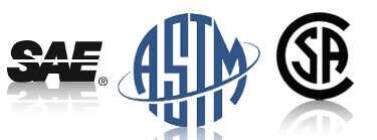What are the differences between F593 and A193 stainless steel headed bolts?
There are many differences between these two specifications. In order to understand these dissimilarities there are overviews of each specification below followed by a short summary of these variances. For the purposes of this FAQ we will be focusing on A193 Grades B8 (Type 304) and B8M (Type 316) versus F593 Alloy Group 1 (Type 304) and Alloy Group 2 (Type 316).
ASTM A193
The fasteners under the ASTM A193 specification are designed to be used in high temperature or high pressure service, often in flanges and piping systems. Headed fasteners in this specification require a heavy hex pattern head unless otherwise specified. Also, threads above 1” in diameter are specified as 8 threads per inch (8UN).
Hot-forged headed stainless steel bolts under the A193 specification require solution annealing after forging to restore full corrosion-resistant properties. If a scale-free bright finish is required, this must be specified in the purchase order. A193 bolts require ASTM A194 heavy hex nuts in the matching stainless steel type.
A193 Marking Requirements include grade symbol and manufacturer’s identifier.
 |
A193/A320 Grade B8 Class 1 |
 |
A193/A320 Grade B8M |
The mechanical properties are listed below.
| Grade | Size | Tensile ksi, min | Yield, ksi, min | Elong, %, min | RA % min | HBW | Rockwell |
|---|---|---|---|---|---|---|---|
| B7 | Up to 2-1/2 | 125 | 105 | 16 | 50 | 321 max | 35 HRC max |
| 2-5/8 - 4 | 115 | 95 | 16 | 50 | |||
| 4-1/8 - 7 | 100 | 75 | 18 | 50 | |||
| B8 Class 1 | All | 75 | 30 | 30 | 50 | 223 max | 96 HRB max |
| B8M Class 1 | All | 75 | 30 | 30 | 50 | 223 max | 96 HRB max |
| B8 Class 2 | Up to 3/4 | 125 | 100 | 12 | 35 | 321 max | 35 HRC max |
| 7/8 - 1 | 115 | 80 | 15 | 35 | |||
| 1-1/8 - 1-1/4 | 105 | 65 | 20 | 35 | |||
| 1-3/8 - 1-1/2 | 100 | 50 | 28 | 45 | |||
| B8M Class 2 | Up to 3/4 | 110 | 95 | 15 | 45 | 321 max | 35 HRC max |
| 7/8 - 1 | 100 | 80 | 20 | 45 | |||
| 1-1/8 - 1-1/4 | 95 | 65 | 25 | 45 | |||
| 1-3/8 - 1-1/2 | 90 | 50 | 30 | 45 |
ASTM F593
The F593 specification is more of a general purpose stainless steel specification used in all different applications. The headed bolts in the F593 specification require a standard hex head pattern (as opposed to heavy hex) unless otherwise specified. Diameters above 1” require Unified National Coarse (UNC) threads unless otherwise specified.
Hot-forged headed stainless steel bolts under the F593 specification are manufactured to either Condition A or Condition CW which both require solution annealing after forging to restore full corrosion-resistant properties. F593 bolts require ASTM F594 hex nuts in the matching stainless steel type.
One primary difference between A193 and F593 hot-forged bolts is that F593 requires an additional test for susceptibility to intergranular corrosion, which the A193 specification does not. This test adds to both the cost and lead time to produce this grade of stainless headed bolt.
F593 Marking requirements include grade symbol and manufacturer’s identifier. The mechanical properties for these two alloy groups are listed below.
| Alloy Group | Condition | Marking | Diameter Range | Tensile, ksi | Yield, ksi min | Rockwell Hardness |
|---|---|---|---|---|---|---|
| 1 | AF | F593A | 1/4 to 1-1/2 | 65 to 85 | 20 | B85 max |
| A | F593B | 1/4 to 1-1/2 | 75 to 100 | 30 | B65 to 95 | |
| CW1 | F593C | 1/4 to 5/8 | 100 to 150 | 65 | B95 to C32 | |
| CW2 | F593D | 3/4 to 1-1/2 | 85 to 140 | 45 | B80 to C32 | |
| 2 | AF | F593E | 1/4 to 1-1/2 | 65 to 85 | 20 | B85 max |
| A | F593F | 1/4 to 1-1/2 | 75 to 100 | 30 | B65 to 95 | |
| CW1 | F593G | 1/4 to 5/8 | 100 to 150 | 65 | B95 to C32 | |
| CW2 | F593H | 3/4 to 1-1/2 | 85 to 140 | 45 | B80 to C32 |
Summary
There are multiple differences between these two specifications. The A193 specification is designed for use in high-temperature, high-pressure applications whereas F593 is used as more of a generic, all-purpose use fastener. There are varying mechanical properties between the two specifications along with configuration differences for headed bolts and varying thread pitch requirements. There are also additional testing requirements for F593 which are not required under the A193 specification.
Do you have a job that requires A193 or F593 stainless steel fasteners? Give Portland Bolt a call – our experts are standing by to assist you with all of your stainless steel fastener needs.


Which specification is generally recommended to reduce electrolysis from exposure to condensation, A193 or F593 for 1/2″ to 1″ dia. track head bolts and nuts ? PSI’s are 30 to 60 psi. Thank you!
@Timothy- The those two stainless grades are identical chemically, with only slight differences in mechanical requirements. We’d would think both would react very similarly. As far as if one is preferred by the industry, we are not able to say.
I’m looking at a connection detail that specifies a cover made with 5052 aluminum, the base connection plate is A709 Grade 36 steel and the bolt is ASTM A307. I see this as a dissimilar materials situation with potential corrosion issues (this is exposed to the elements in Florida). The cover plate is aluminum for removal purposes. I understand there are some stainless steel grade that are more compatible with aluminum/steel interaction, but I can’t recall which ones. Is there one you can recommend?
@Rudolf- Apologies, but we do not have any metallurgists on staff and are unable to make specific material recommendations.
Hi Rudolf,
According to me, you should consider using PTFE (barriers, washers, ferrules) between dissimilar materials: Aluminum vs A709, Aluminum vs A307. In case stainless steel bolts are employed, there would be corrosion between SS bolts and the two others.
Which ASTM nuts and bolts would you recommend for 4″ flanged in a sewage lift station wet well?
I have a feeling A193…
@Phillip- We are unable to make specific application recommendations. That said, A193 bolts are commonly used in flange applications, and one of the grades within A193 will likely work. You’ll have to have an engineer familiar with the project tell you which grade would be best.
Wondering if in general, one is cheaper than the other?
@Joe- It will depend on what specific part you are looking for. If it is something small and mass produced overseas, the F593 might be less expensive. However if you need something out of the ordinary, the A193 might be a better option, it will just depend on your bolting needs.
Thank you for this explanation of these two similar but different alloys.